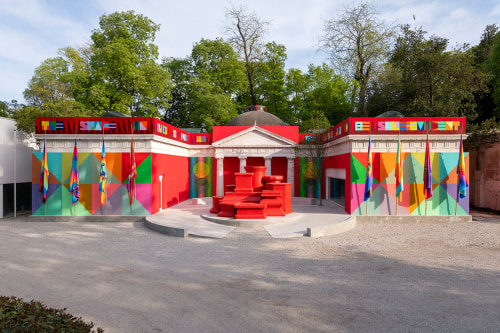

The United States Pavilion at the 60th International Art Exhibition of La Biennale di Venezia presents a multidisciplinary exhibition by Jeffrey Gibson, an artist recognized for a hybrid visual language that employs abundant color, complex pattern, and text to articulate the confluence of American, Indigenous, and Queer histories and imagine new futures. Gibson’s exhibition for the U.S. Pavilion, the space in which to place me, engages concepts that have shaped the artist’s practice over his 20-year career. Bringing together sculpture, multimedia paintings, paintings on paper, and video, the exhibition explores the dimensions of collective and individual identity and the forces that shape its perception across time.
The 2024 U.S. Pavilion is presented by Portland Art Museum in Oregon and SITE Santa Fe in New Mexico, in cooperation with the U.S. Department of State’s Bureau of Educational and Cultural Affairs. The Pavilion is commissioned by Kathleen Ash-Milby, Curator of Native American Art at the Portland Art Museum and a member of the Navajo Nation; Louis Grachos, Phillips Executive Director of SITE Santa Fe; and Abigail Winograd, independent curator. The exhibition is curated by Winograd and Ash-Milby, who is the first Native curator to organize a U.S. Pavilion. Gibson joins an esteemed group of contemporary artists who have represented the United States on the Biennale Arte’s global stage and, as a member of the Mississippi band of Choctaw Indians and of Cherokee descent, he is the first Indigenous artist to represent the country with a solo exhibition.
the space in which to place me considers Indigenous histories within an American and international context, expanding upon the varied materials and forms that Gibson has employed over the past two decades. The title references Oglala Lakota poet Layli Long Soldier’s Ȟe Sápa, a poem whose geometric shape parallels Gibson’s meditation on the physicality of belonging. Gibson often draws influence from poetry and literature, as well as music, fashion, and theory, which materialize in his intuitive use of text. This long-held engagement continues throughout the space in which to place me. Gibson incorporates language from foundational American documents from the late 19th and early 20th centuries, including constitutional amendments, legislation, speeches, and official correspondence, as well as song lyrics and musical references. Often pointing toward moments in history that were meant to spark change, Gibson’s use of text encourages viewers to examine our past when considering the present.
Image: Exterior view of the space in which to place me (Jeffrey Gibson’s exhibition for the United States Pavillon, 60th International Art Exhibition – La Biennale di Venezia), April 20 – November 24, 2024. Forecourt sculpture: the space in which to place me (2024). Photograph by Timothy Schenck.